I’ve been interested in shortwave radio since I was a teenager, and over the decades I’ve owned quite a few shortwave radios. Now it’s time to downsize and I’ve been selling radios on eBay right and left, 61 so far. As the inventory dwindles, it’s time to decide what to keep.
Some I want to keep for sentimental value and some to use. The first shortwave radio I had was in the 1960’s in high school, a Nanaola Model 10NT504. That radio is long gone, but I found a photo of one online:

It had MW, longwave and 3 shortwave bands. The two features I fondly remember were the dial light button and the concentric tuning control with the outside control knob for coarse tuning and the central knob for fine tuning. It worked quite well.
My next radio was a Lafayette KT-340, a multi-band shortwave radio that I built from a kit. This is what it looked like:

Here’s a photo from 1967 of me with both of these radios.
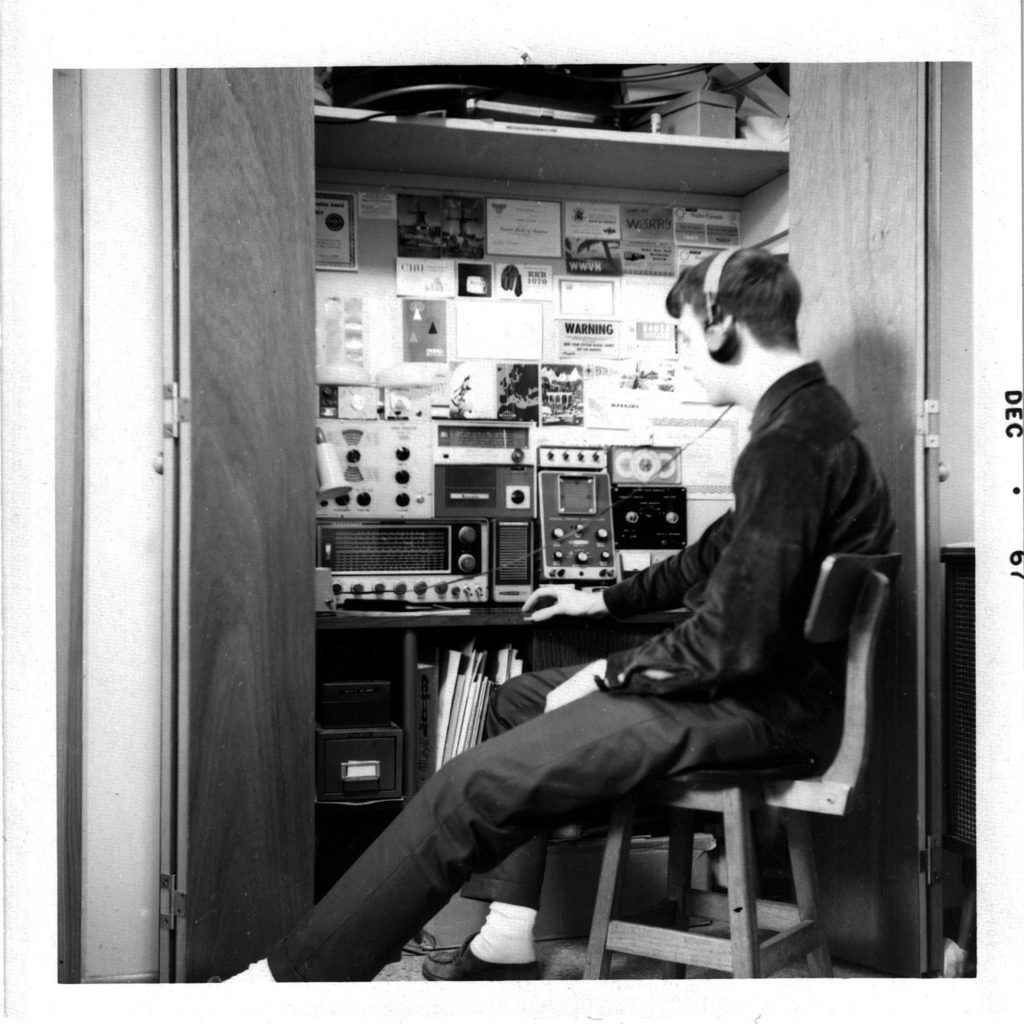
A number of other radios have come and gone including a RadioShack DX-60, DX-300 and DX-400 that I very much enjoyed at the time, but back to the question of what to hang onto from the existing accumulation.
Panasonic RF-085
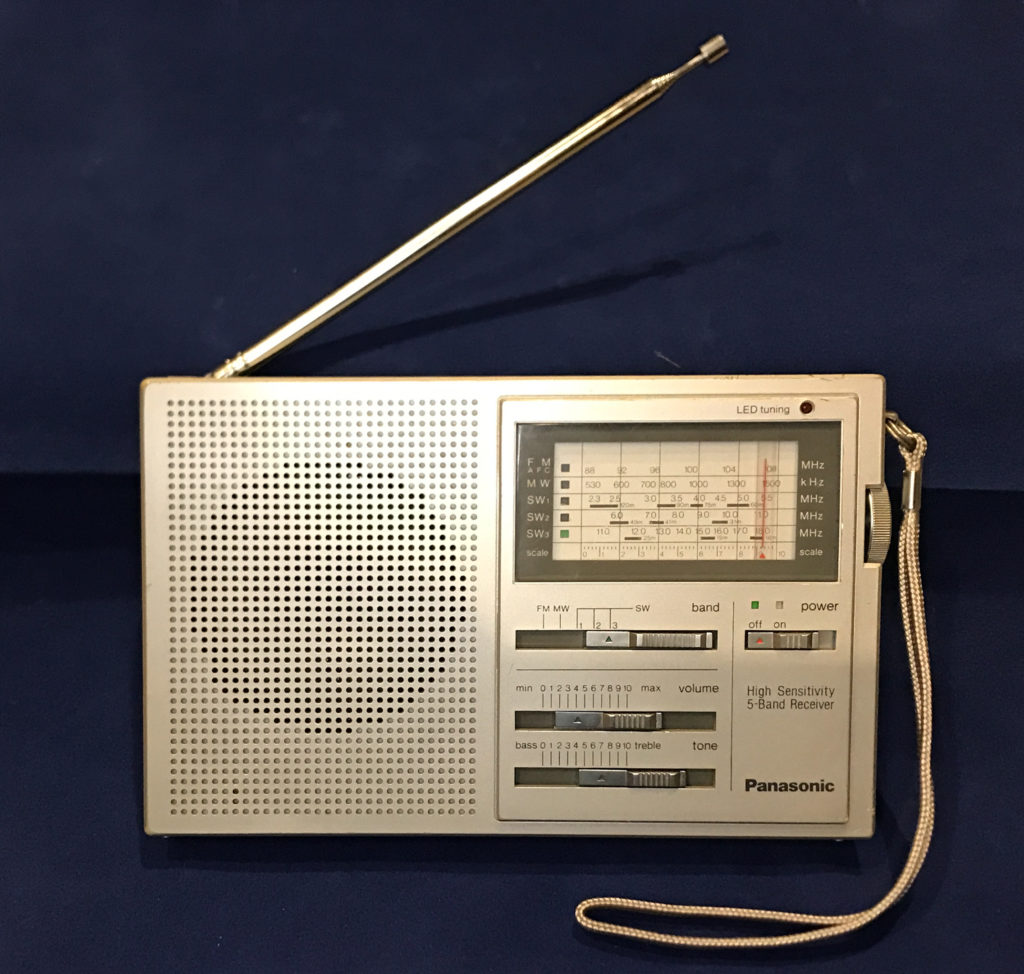
This is the oldest shortwave radio I still own. They were made around 1985. It’s a single conversion AM/FM/Shortwave radio. Shortwave is segmented into 3 bands providing continuous coverage from 2.3 to 18 MHz; it has an LED tuning indicator and a tone control, plus a connection for an external antenna that can be wired as a dipole for FM or a long wire with ground for MW and shortwave. That’s pretty advanced, and the only radio I still have with an explicit connection for ground. I still have the external AC power supply for it. This one is definitely a keeper for sentimental reasons.
I took it for a spin and I was immediately impressed by the big sound from the speaker. It latched onto stations well and the LED tuning indicator was helpful. One thing stuck me about tuning this receiver, that it is quiet between stations, where I’m used to hearing a great deal of noise. I finally found my original Panasonic RF-085 Operating Instructions (manual) and since there appears to be none online, I scanned it put it here on the blog as well as some product specifications I found online.

Lextronix E1100
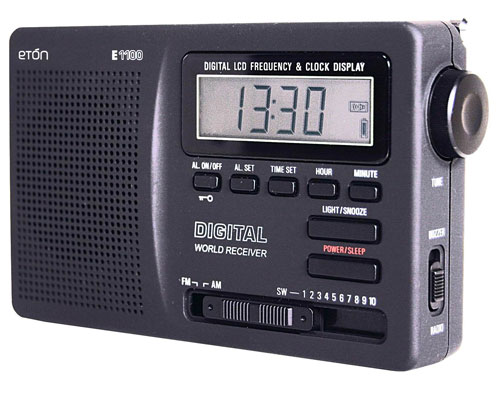
The E1100 (AKA Tecsun DR-920, AKA Grundig G1100) is a very simple radio, a basic analog tuned, single conversion radio with a digital frequency display. It receives AM, FM and 10 shortwave bands. I used to have two of these and I gave one to a friend who had been a ham radio operator earlier in his life. He died of cancer and I heard that he enjoyed the radio towards the end. So this radio reminds me of him.
I gave the radio a try and was pleasantly rewarded with a good number of stations from this sensitive receiver. [This dial string subsequently failed and the radio is no longer tunable. I replaced it with the similar DR-920C.]
Next: Three radios from Tecsun on my potential keeper list
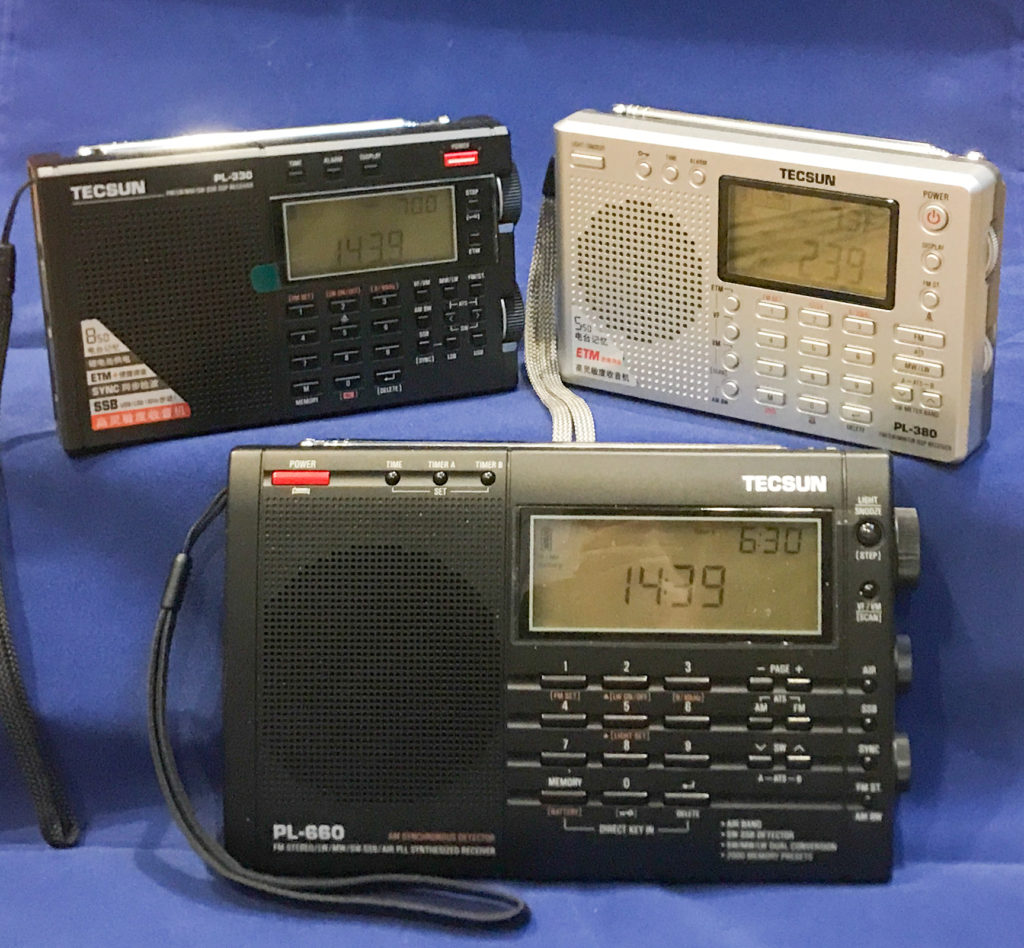
Tecsun PL-660
I think this is probably the best radio I have, making it a strong candidate for a keeper. It has a staggering 2000 memories, covering AM/FM/LW/SW with SSB demodulation and synchronous detection. It’s my only air band radio, not that I listen to that very often. This radio is larger and heavier, less amenable to travel. It has an external antenna jack.
Tecsun PL-380
I bought several digital signal processing radios from Tecsun over the years looking for the ultimate travel radio. The PL-380 has been around the world with me and it has done a very good job. It has automatic band scanning, 550 memories, and direct frequency entry. It also has a thermometer. The one odd omission is that it lacks an external antenna jack. It’s a very compact radio lightweight radio, has nice padded case and can charge its 3 AA batteries with a mini USB cable. It was definitely on my keeper list, at least until recently when I bought the next model. Now it’s sold.
Tecsun PL-330
This moderately-priced radio does it all, building on the PL-380 while adding SSB demodulation and synchronous detection. It also has Enhanced Tuning Mode (ETM+) that scans the entire shortwave band and stores the stations it finds in a separate bank of memories for each hour of the day. That’s on top of other banks of memories that can be scanned and stored separately. It adds the external antenna jack, but loses the thermometer. This radio uses a smaller rechargeable battery, making it thinner and lighter than the PL-380. It uses a micro USB cable for charging. This one goes on my next trip.
What I don’t like about the PL-380 and the PL-330 is that it’s obvious that they use synthesized tuning as there is a chuffing sound between each frequency tuned. The PL-660 doesn’t have that unpleasantness.
That’s it for the serious shortwave listening radios, but there are a few more keeper candidates.
Zhiwhis ZWS-603
This was a $24.99 whim from Amazon, the Zhiwhis (I hear that as “gee whiz”) ZWS-603. It not only has MP3 but also Bluetooth and a feature I wish I had in other radios, recording (from four sources: an internal microphone, an audio cable, Bluetooth and the radio). It also has a remarkable 3W speaker and a claimed bass port (keeping in mind that the speaker is only 2.7″). This is what it looks like:

On a 19″ monitor, that picture is a 50% bigger than the real radio.
We’ll see if this one is a keeper. One major drawback is that it has no clock.😱
Degen DE15
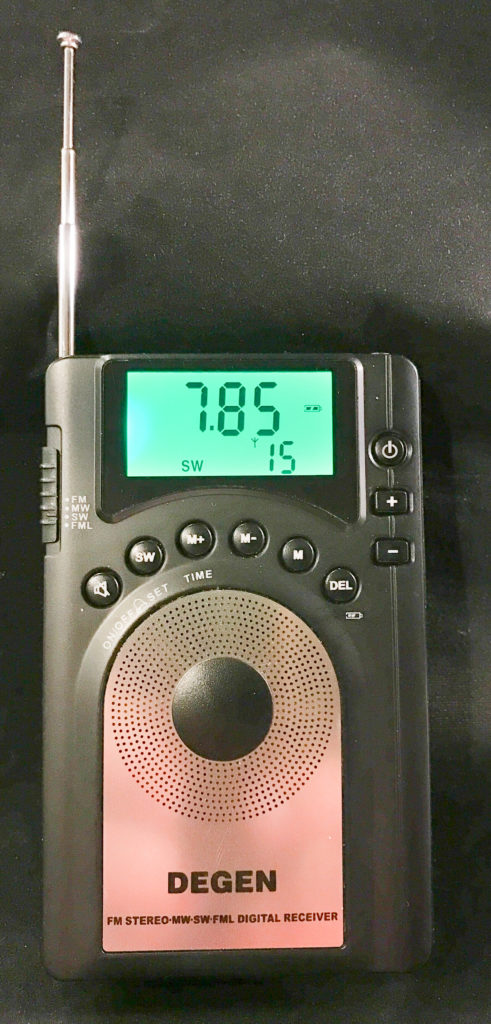
I just like the ergonomics of this one and the really bright green screen. It’s as bright as in the photo but more intense green. It has synthesized tuning and can also use a USB cable to charge batteries (3 AAA in this case). It’s definitely a shirt-pocket radio. It also sounds rather good, especially with stereo headphones. It’s main drawback is that it lacks a tuning dial, relying instead on buttons and scanning.
A new/old entry – Kaito WRX911
I discovered that I had salted away a Kaito RWX911 because it had such a nice metallic blue color and it had a real tuning dial.

One useful technique for keeping within my 9 shortwave radio budget is reclassification; therefore, any radio with a weather band is classified a “weather radio” whether it has shortwave or not, a radio up for auction on eBay or that didn’t sell is classified as “stored stuff” and a software defined radio is classified as an SDR (after all, it can receive weather!). I have two weather radios, around 6 “stored stuff” radios and one SDR.
Kaito KA29
This article continues to be updated. In addition to the 7 (by my count) radios in the list, I added a Kaito KA29. This shortwave radio can be used as a recording device and it has very good sound with quality headphones. Whether I’ll keep it for the long term is an open question. The display and button labels are very easy to read, but operation is somewhat counterintuitive, and shortwave coverage is separated into bands, leaving gaps between.
I’ve written another article comparing the Zhiwhis ZWS-603 and the Kaito KA29. Zhiwhis ZWS-603 vs Kaito KA29, These two radios occupy one niche and probably one of them will be retired or reclassified somehow.
That leaves one slot open
Originally that slot was reserved for an XHDATA D-808, an excellent radio that I thought I was going to get for a good price, but two orders for one defaulted and I’m left with the option of paying over $100. The radio might arguably be worth that (or not), but I already have two solid Tecsun radios for serious listening.
There are now 9 radios on the keeper list:
- Tecsun PL-660 (because it doesn’t chuff, is a great all around radio, has SYNC, and air band)
- Tecsun PL-330 (lightweight and convenient for travel, Enhanced Tuning System, and SSB)
- Eton E1100 (same as Tecsun DR-920, sensitive and simple)
- Kaito RWX911 (same as Tecsun R-911, because it’s blue and has a real tuning dial)
- Degen DE15 (a true pocket radio with a bright display, synthesized tuning, but alas no tuning knob)
- Panasonic RF-085 (my oldest remaining radio, sentimental, about the same size as the PL-660, great sound and remarkably quiet tuning shortwave)
- ZHIWHIS ZWS-603 (because I can record with it and it has a big 3W speaker and a “bass port.” I can use it to boost the sound of the other smaller radios and it has a very low price
- Kaito KA29 (because it has big buttons and orange accents)
- TBD
Update
Well the whole scheme fell apart. After dumping nearly 100 radios, I bought some more. Several of them have reviews on this website. Notable among the new ones is an Eton Elite Executive that I got a sweet deal on, a Tecsun R-9700DX, an XHDATA D-808, D-109 , D-219), a Sangean ATS-405 a Raddy RF75A and most recently, a Tecsun PL-880. I also have a number of budget entries not especially worth mentioning, 3 of which will appear in our local fire and rescue fundraising yard sale. My current radio count for all types (excluding car radios) is 36.

I also picked up a TINY HanRongDa HRD-701 (AM/FM/SW/NOAA Weather/MP3/Bluetooth speaker), that’s a pretty decent package for its $35 price range. It also plays MP3 files. I got a yellow one.
I also bought a Rysamton YK-M03 for under $13 on an Amazon lightning deal. It works remarkably well for the price.
I’ve recently bought the tecsun pl 660,it was a tight competition between d808 and pl 680,but I selected the first one because of its excellent Shortwave,medium wave sensitivity.Pl 680 is basically same with square buttons with same specs,some says it isn’t good for medium wave.D808 is kinda copy of skywave with dsp but I wanted an old school non dsp radio with good speaker so the pl 660.My decision was right,I own a rtlsdr v3 and sdrplay duo too.I am highly satisfied with pl 660,its new batch is unique.
Anybody who knows me could have guessed that the 9-radio limit wouldn’t stand. I’ve added a few. One I didn’t see coming was an Eton Elite Executive, unforeseen because it’s priced around $179; however, Woot had a blow-out sale for $79.99 and I snagged one. On the low end, I got a few, including a Degen DE28, a shirt-pocket version of the KA29. I lost a weather radio, ruined because it got wet!!!!
Good buy on the Eton Elite Executive, which is internally almost identical to the XHDATA D-808 but with a more solid build that uses regular AA batteries vs a rechargeable protected cell. I got an Eton Elite Executive on sale (not quite as good of a deal as you found, but good enough), and have been pleasantly surprised by its performance on all the bands, especially MW. Compared to the D-808, the Elite Executive sacrifices a bandwidth filter (2K instead of 1.8K on the 808) but is in most all other performance respects the same receiver with a nicer build and a better speaker. I would definitely add the Eton to your list of “keepers”!
While my “go to” radios remain the Tecsun PL-330 and PL-660, the Elite Executive is a very nice radio. I just wish it didn’t fall over so easily. The main reason I don’t use it more is that I’m more familiar with the others.